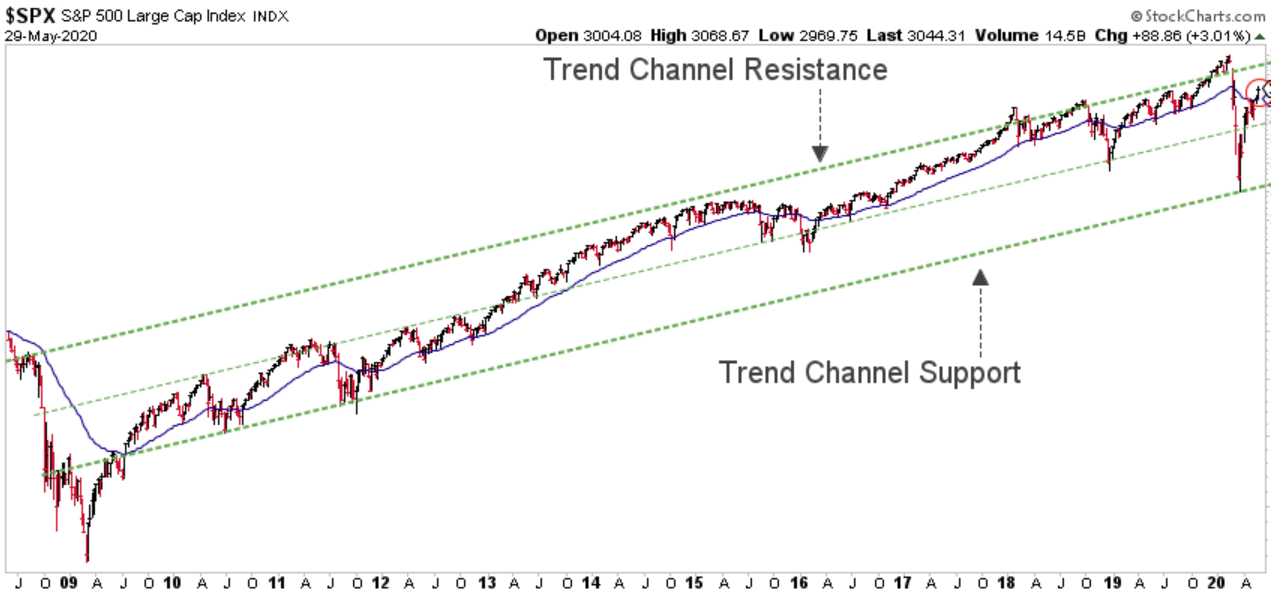The US stock market, as measured by the S&P 500 Index (S&P), finished the month of May 3.4% above the Blue Line, compared to 1.3% at the end of April. While price has begun to rise above the Blue Line, the Green and Purple Lines (not shown) continue to remain below or at the Blue Line.
BLUE LINE PERSPECTIVE

Chart courtesy of StockCharts.com
As a quick reminder, the ideal pattern for what we believe constitutes a sustainable, rising trend is when price is above the Green Line; the Green Line is above the Purple Line; and the Purple Line is above the Blue Line. At this time price is above the Blue Line, the Green Line is at the Blue Line, and the Purple Line remains below the Blue Line.
Since 1926, I have identified five instances where one of our indicators (not shown) has behaved similarly to what has transpired over the past few months. These instances occurred during calendar years 1930, 1940, 1962, 1987, and 2009. Of these five, the two that I believe are most relevant are 1930 and 1940. While I realize this is not a large sample size, I want to share some additional insight based on what I have written above.
During 1930, price rose 6% above the Blue Line on the rebound. The Green Line rose above the Blue Line as well, but the Purple Line did not. The S&P eventually rolled over and declined to new price lows over the ensuing months.
During 1940, price rose 4% above the Blue Line on the rebound. The Green Line once again rose above the Blue Line, but the Purple Line did not. The S&P eventually rolled over and declined to new price lows over the ensuing months.
While it is still too early to come to any conclusions at this time, I continue to believe caution is warranted. While there are no guarantees the S&P will repeat the past, I believe these patterns can help with investment decisions, especially those involving the stock markets.
PRIMARY TREND PERSPECTIVE
What I see from the rising trend channel below is that it appears the price decline of March was a type of Channel Correction; a concept I discuss in Chapter 5 of my book due out the end of August. If this trend channel is identified correctly, it could help identify when the trend is turning negative in the future (whether measured in months or years). I believe this can help investors identify when to sell some or all of their stock investments to attempt to preserve their wealth during such periods.

Chart courtesy of StockCharts.com
Thank you for reading the BLUE LINE INVESTING® PRIMARY TREND update, and please do not hesitate to call (833) 258-2583 with questions or if we may be of service.
Jeff Link
Disclaimers:
BLUE LINE INVESTING® (BLI) is an actively managed investment process that pursues our mission by combining a trend following investment philosophy and a “buy low, sell high” investment strategy. Our mission is to grow our client’s financial wealth over a full market cycle in a risk-managed and tax-efficient way.
We monitor the relationship between price and the Blue Line over time to help identify which stock markets worldwide are experiencing rising, sideways, and declining primary trends. We prefer to invest in those markets experiencing rising or sideways primary trends, while avoiding those markets experiencing declining primary trends. The Blue Line helps us identify these trends, and when changes may be taking place.
The S&P 500 Index is one of the most commonly followed equity indices, and many consider it one of the best representations of the U.S. stock market, and a bellwether for the U.S. economy. It is comprised of 500 large companies having common stock listed on the NYSE or NASDAQ. The volatility (beta) of the account may be greater or less than the index. It is not possible to invest directly in this index.
Technical analysis is a method of evaluating securities by analyzing statistics generated by market activity, such as past prices and volumes. Technical analysis attempts to predict a future stock price or direction based on market trends. The assumption is that the market follows discernible patterns and if these patterns can be identified then a prediction can be made. The risk is that markets may not always follow patterns. There are certain limitations to technical analysis research, such as the calculation results being impacted by changes in security price during periods of market volatility. Technical analysis is one of many indicators that may be used to analyze market data for investing purposes and should not be considered a guaranteed prediction of market activity. The opinions expressed are those of BLI. The opinions referenced are as of the date of publication and are subject to change without notice. BLI reserves the right to modify its current investment strategies based on changing market dynamics or client needs.
Past performance is not indicative of future results. This material is not financial advice or an offer to sell any product. The information contained herein should not be considered a recommendation to purchase or sell any particular security. Forward looking statements cannot be guaranteed.
Guardian Wealth Advisors, LLC (“GWA”) is an investment adviser registered with the U.S. Securities and Exchange Commission. Registration does not imply a certain level of skill or training. More information about GWA’s investment advisory services can be found in its Form ADV Part 2, which is available upon request.
GWA-20-04




